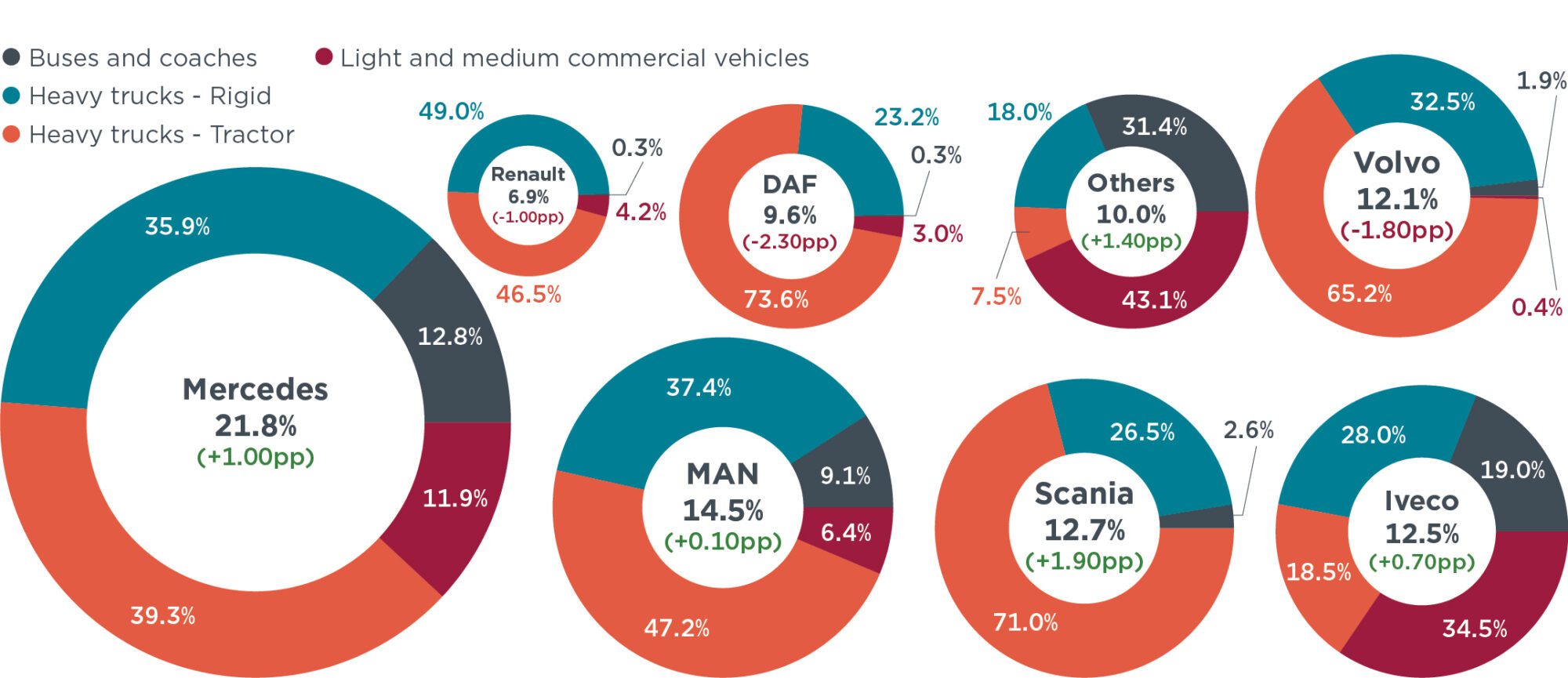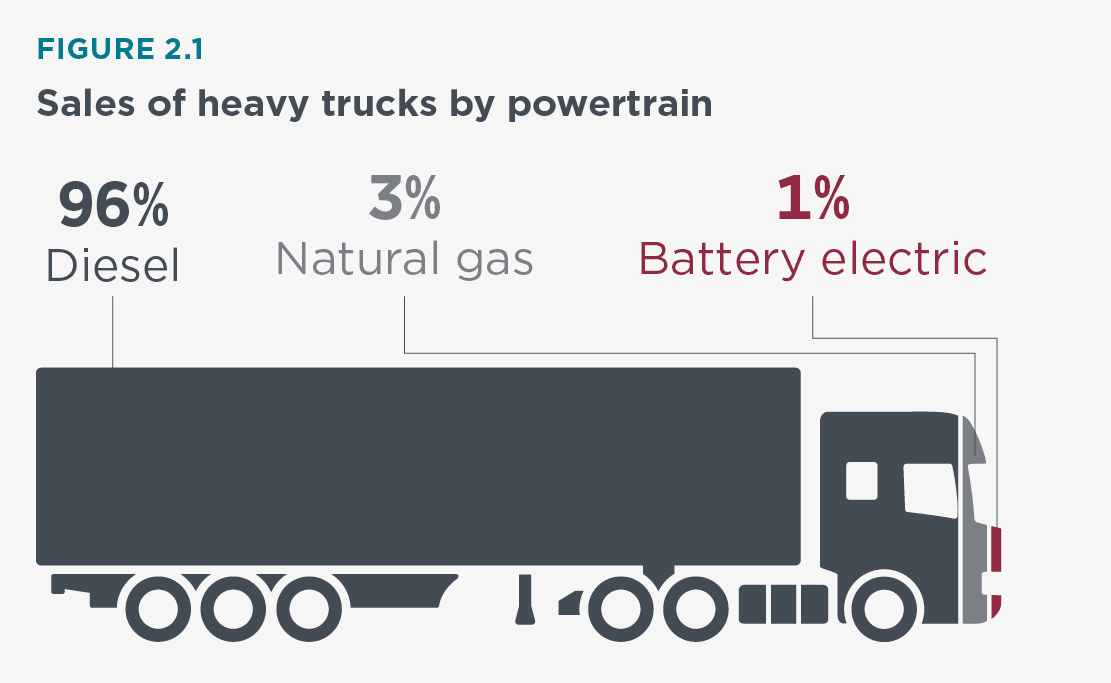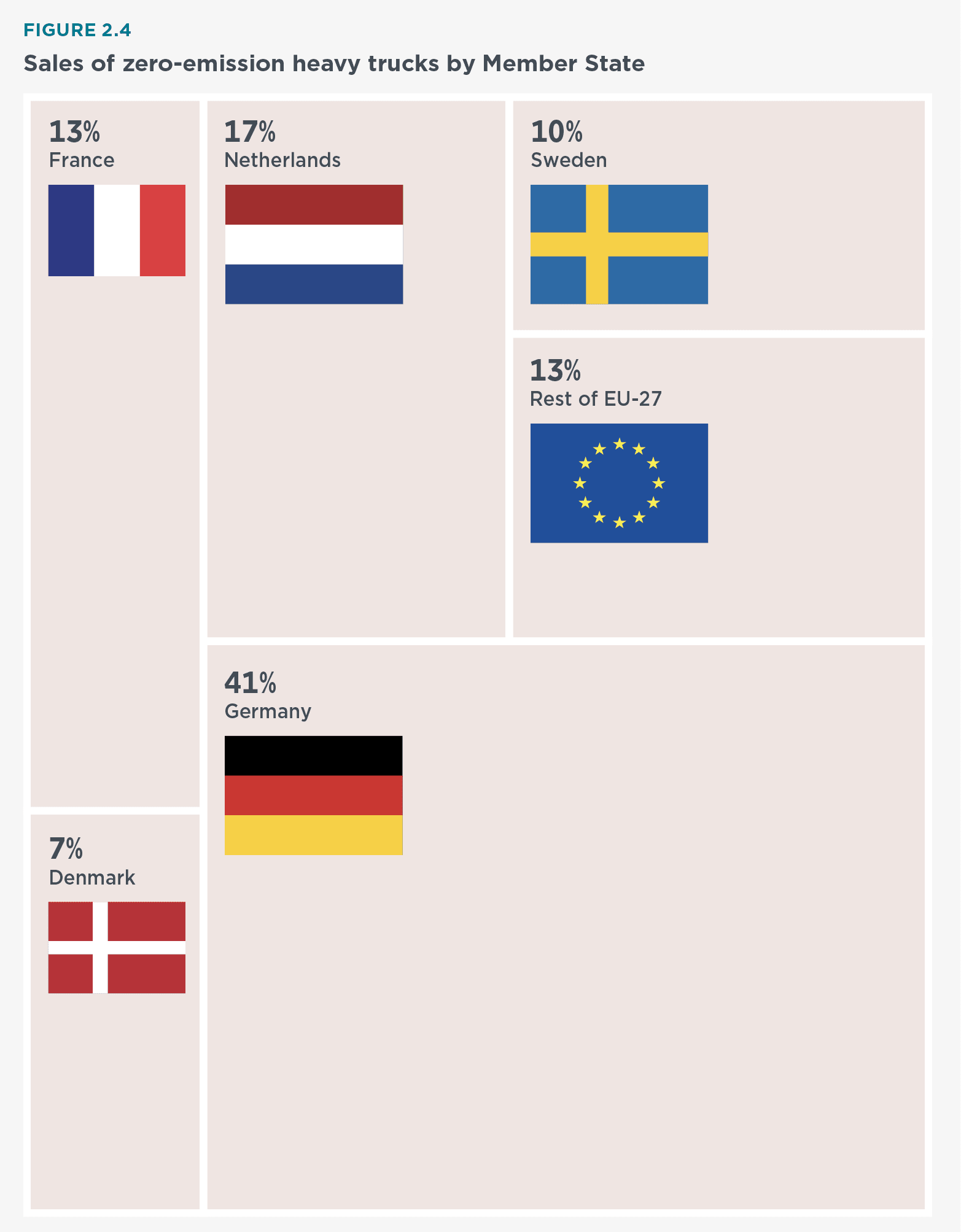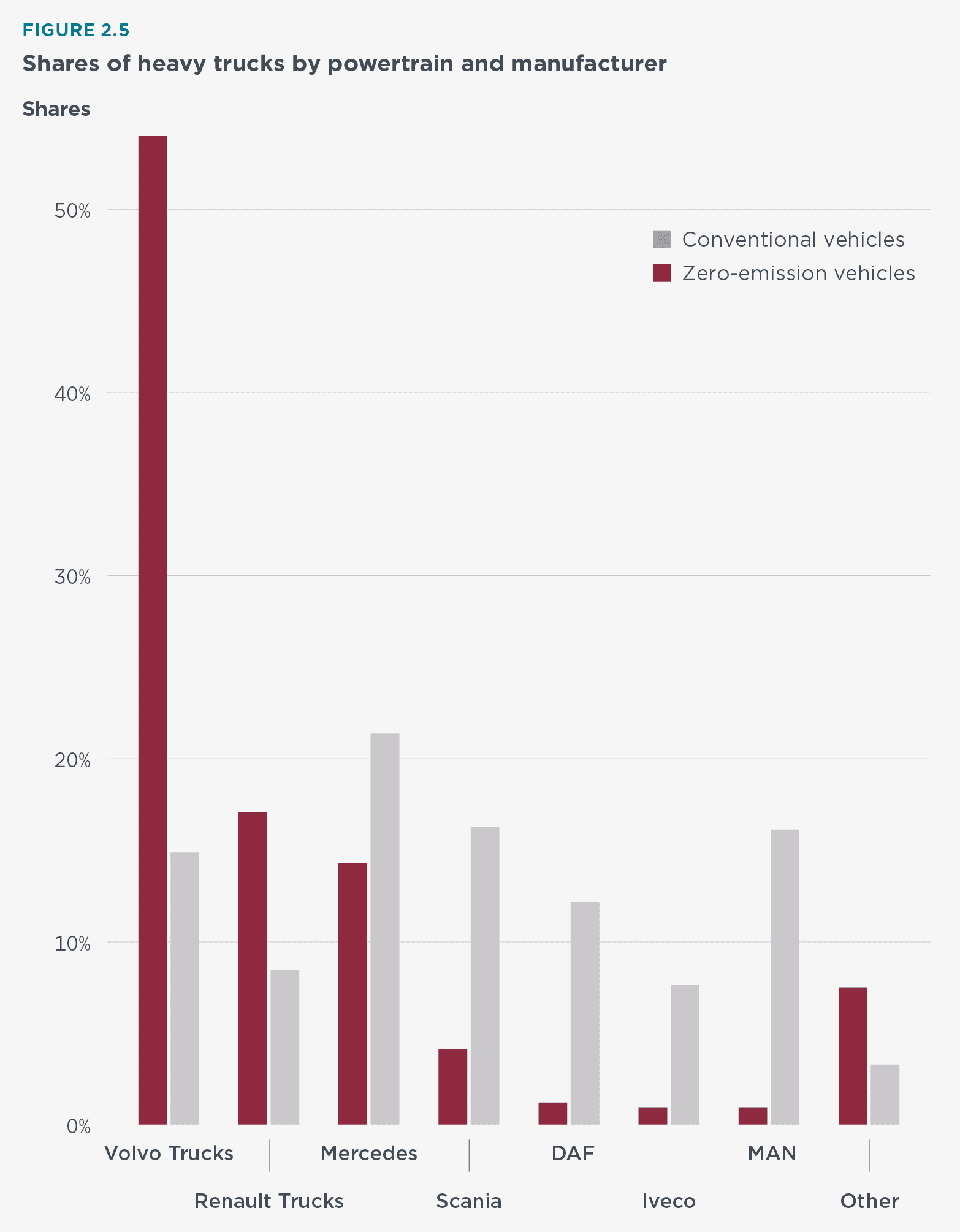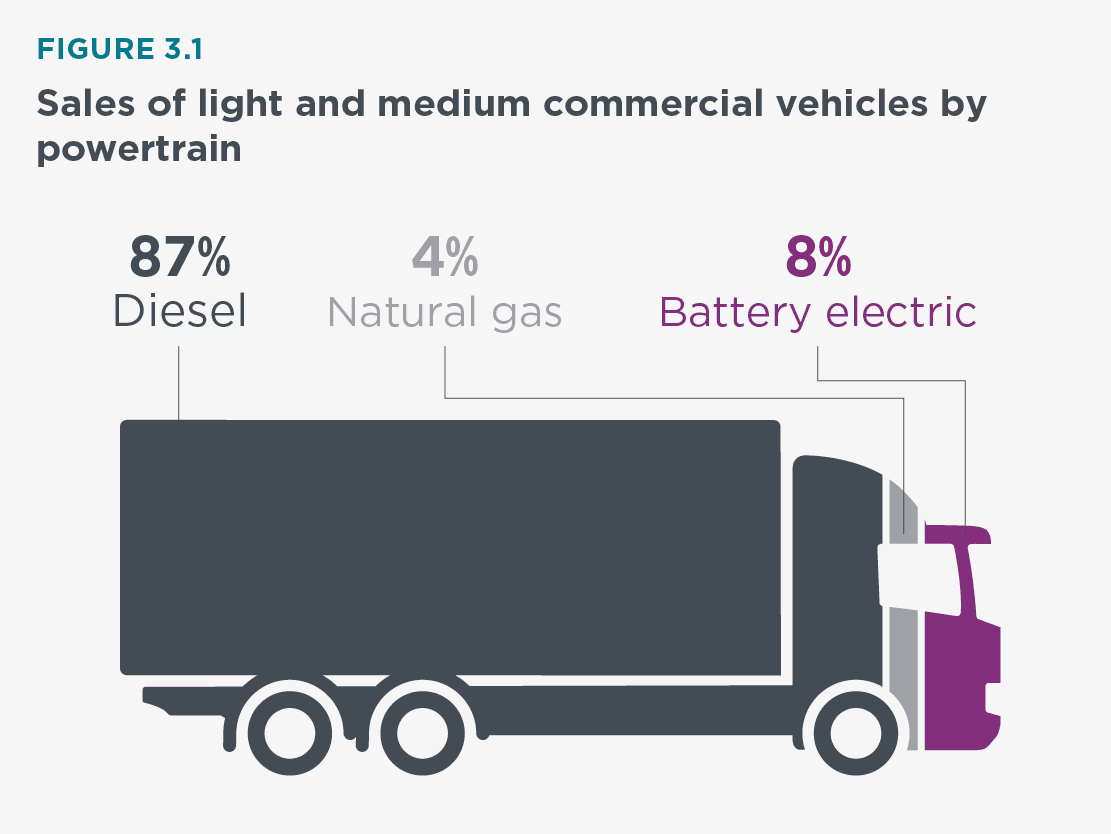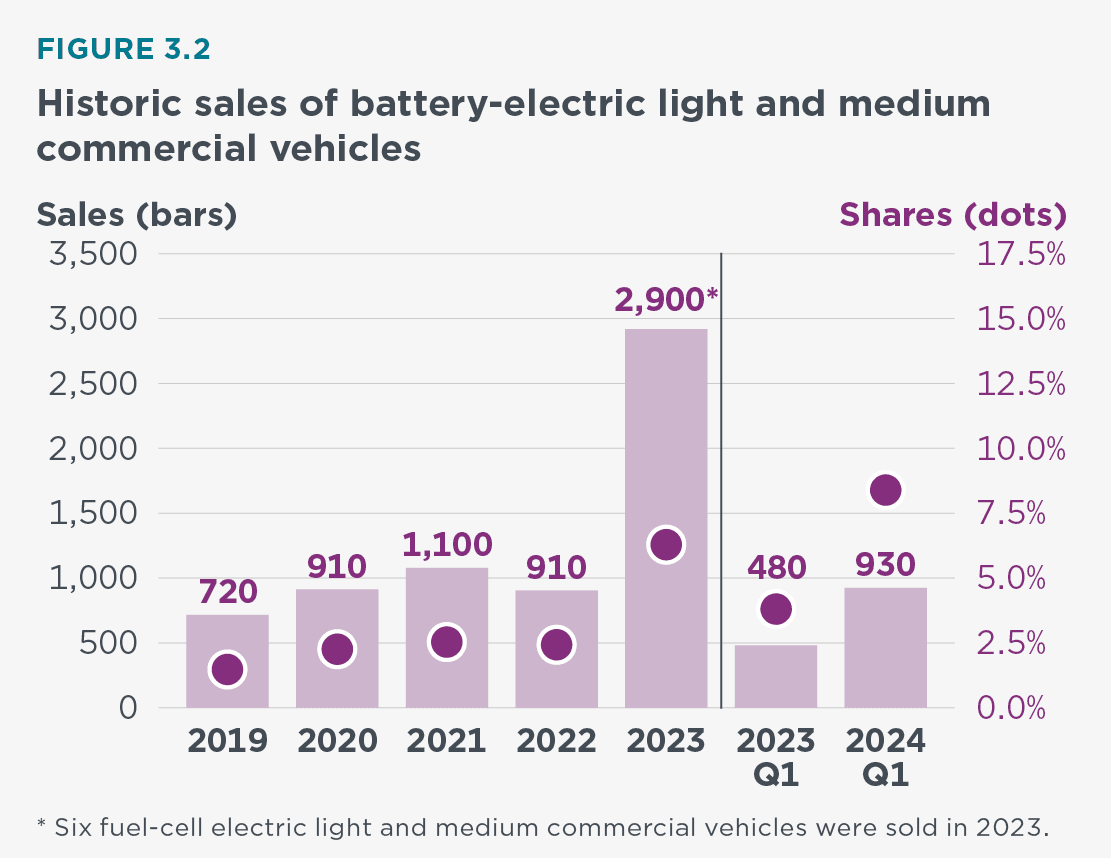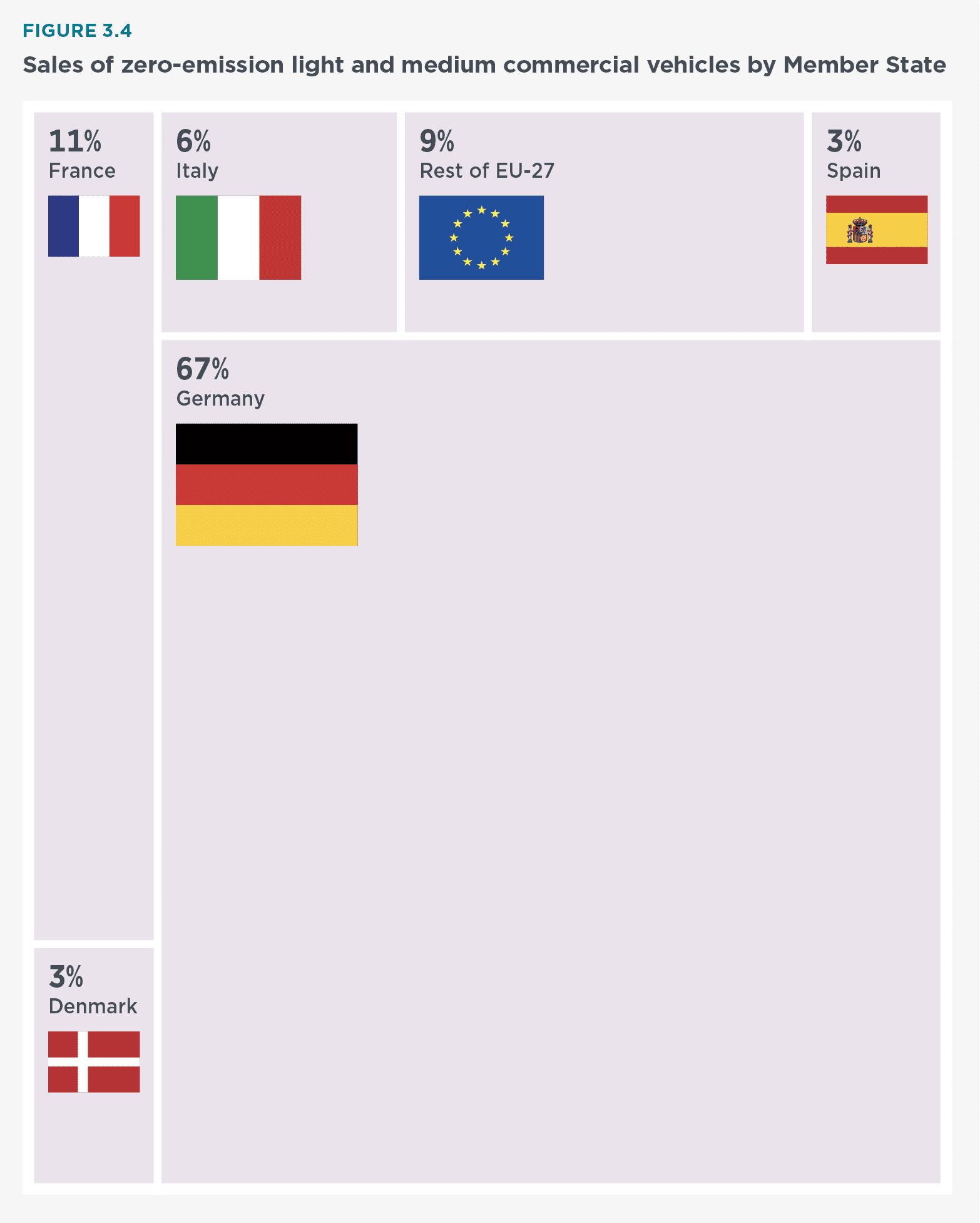Race to Zero
European heavy-duty vehicle market development quarterly (January–December 2023)
Market Spotlight
Race to Zero: European Heavy Duty Vehicle Market Development Quarterly (January – March 2024)
Summary
In the first quarter of 2024, the market for zero-emission heavy-duty vehicles (HDVs) grew considerably, despite a contraction in overall HDV sales of 9% compared to the first quarter of 2023. The sales share of zero-emission vehicles (ZEVs) increased in all three segments—heavy trucks, light and medium trucks, and buses and coaches— compared to the first quarter of 2023. Germany continued to lead in zero-emission HDV sales, accounting for 40% of all sales in the EU-27.
Zero-emission heavy trucks represented more than a 1% share of the market, up from 0.5% at the end of the first quarter in 2023. In the light and medium segment, zero-emission vehicles made up more than 8% of sales in the first quarter of 2024, up from 6% at the end of the first quarter in 2023. Similarly, zero-emission buses accounted for 12% of bus and coach sales in the first quarter of 2024, up from less than 5% at the end of the first quarter of 2023.
Overall market developments
More than 86,000 HDVs, across all powertrain types, were sold in the EU-27 in the first quarter of 2024, a 9% decrease from the same period in 2023. Sales in the three biggest European markets—Germany (25,000), France (15,000), and Italy (9,000)—which together represented 57% of all HDV sales in the European Union (EU)—increased compared to the first quarter of 2023 (27%, 16%, and 9%, respectively), while the Spanish market shrank from 8% to 5%.
The seven top selling HDV brands in the EU represented 90% of all sales in the first quarter of 2024. Mercedes-Benz, the top selling brand (22%), consolidated its market share by an additional 1 percentage point (pp) compared to the first quarter of 2023. It was followed by MAN (15%, +<1pp), Scania (13%, +2pp), Iveco (13%, +1pp), Volvo (12%, -2pp), DAF (10%, -2pp), and Renault (7%, -1pp).
Heavy trucks represented more than 95% of the sales of brands Scania, DAF, Volvo Trucks and Renault Trucks, while IVECO proportionally sold fewer heavy trucks (47%) than light and medium commercial vehicles (35%), and buses and coaches (19%). DAF had the highest share of tractor trucks in its sales mix (74%), followed by Scania (71%) and Volvo (65%). Other manufacturers, which represent 10% of the market, sold mostly light and medium commercial vehicles (43%) as well as buses and coaches (31%).
Heavy trucks
With a gross vehicle weight above 12 tonnes
In the first quarter of 2024, heavy trucks represented 77% of all HDV sales in the EU-27. Of the 67,000 heavy trucks sold in the first quarter, 750 (1.1%) were ZEVs. This is double the share of the first quarter of 2023, when only 500 of the 77,000 (0.6%) heavy trucks sold were ZEVs.
Germany continued to lead in total share of zero-emission heavy truck sales in the EU-27 in the first quarter of 2024 with 15%; France followed with 13%. In comparison, in the first quarter of 2023, sales in Germany represented 23% of all zero-emission heavy truck sales; sales in France were 16%. In the first quarter of 2023, 10% of zero-emission heavy trucks were sold in Spain, however, sales in Spain were less than 1% of the EU-27 total in the first quarter of 2024.
Volvo Trucks continues to consolidate its leading position in the zero-emission heavy trucks market. It had a 54% share of sales in this segment in the first quarter of 2024 (compared to 44% in the first quarter of 2023). Of Volvo’s battery electric heavy trucks sales, 34% are attributable to the 4×2 FH-Series, which made up 20% of all battery electric heavy truck sales, followed by the 4×2 FM Series, which made up 12%.
Mercedes-Benz increased its conventional heavy trucks sales share by 2 percentage points in the first quarter of 2024 compared to the same period in 2023, while its share in the zero-emission heavy truck market increased from 8% to 15% in the same period.
Light and medium commercial vehicles
With a gross vehicle weight between 3.5 tonnes and 12 tonnes
In the first quarter of 2024, 11,000 light and medium commercial vehicles were sold in the EU-27. Of these, 8% were ZEVs. There was an 8% dip in total sales compared to the first quarter of 2023, when 12,000 vehicles were sold. However, the number of ZEVs sold increased from 450 to nearly 950 in the first quarter of 2024.
In the first quarter of 2024, Germany had the most sales of zero-emission light and medium commercial vehicles (67% of sales compared to 28% in the first quarter of 2023). France had 11% of zero-emission light and medium commercial vehicle sales in the first quarter of 2024 compared to 38% in in the first quarter of 2023.
Ford continues to lead the zero-emission market in this segment, despite a shrinking market share. In the first quarter of 2024, Ford supplied 40% of all zero-emission light and medium commercial vehicles; at the end of the first quarter of 2023, Ford had supplied more than 50%. Fiat more than doubled its share of all zero-emission light and medium commercial vehicle sales in the past year, supplying 30% by the end of the first quarter of 2024 compared to 12% in the first quarter of 2023.
Buses and coaches
With a gross vehicle weight above 3.5 tonnes
Of the 8,850 urban and interurban buses and coaches sold in the first quarter of 2024, 1,100 were ZEVs, a 12% share. City bus registrations in the same quarter amounted to 3,200 units, with 1,100—or 32%—being battery electric.
In the first quarter of 2023, all city buses sold in several countries, including Denmark, Ireland, and the Netherlands, were zero-emission models. In the first quarter of 2024, 1 and 3 conventional diesel buses were sold in Denmark and the Netherlands respectively. In Ireland, diesel bus purchases increased to 40% (60% of bus purchases were battery electric). In France, the sales shares of electric, natural gas, and diesel buses in the first quarter of 2024 were closely split, with natural gas buses accounting for most registrations. In contrast, 100% of the city buses registered in Luxembourg in the first quarter of 2024 were battery electric.
Looking at key market suppliers, Mercedes- Benz increased its market share in the zero-emission bus segment from around 5% in the first quarter of 2023 to nearly 15% by the end of the first quarter of 2024.
Technology focus: Zero-emission truck purchase subsidies in the EU
Looking beyond quarterly sales
Governments can implement several types of policy measures to support the development of the ZEV market. Due to the high purchase cost of ZEVs, and because most transport operators have low access to capital, direct purchase subsidies can be an effective measure to boost ZEV sales in the early adoption phase, though this is not a sustainable long-term measure.
Table 1 details the purchase subsidy programs available for zero-emission trucks across European countries, together with relevant provisions. As of May 2024, 11 countries in the EU-27, as well as Norway and the United Kingdom, offer direct purchase subsidy schemes to transport operators. These incentives typically depend on factors including company size, vehicle type, and whether a previous vehicle has been scrapped. France has agreed on a subsidy scheme for 2024 that has not yet started as of May 2024. Notably, France and Belgium subsidize the acquisition of battery-electric vehicles only. Germany, the largest market for these vehicles within the EU-27, discontinued its subsidy program (KsNI) in February 2024, and is allocating its budget to other supporting mechanisms, including the build-out of a comprehensive charging infrastructure network.
Beyond subsidies, other financial incentives such as comprehensive tax benefits are available in countries like Belgium, Denmark, France, and Spain, which could motivate companies to invest in ZEVs. Austria, the Czech Republic, Germany, and Hungary offer CO2– based road tolls for diesel trucks and a simultaneous exemption or reduction for zero-emission heavy vehicles, following the Eurovignette Directive. Additional sub-national subsidies may also exist.
| Country | Implementing agency | Program | Funding available and time window | Eligibilitya | Subsidy amountb | Link to more information |
| Austria | The Austrian Research Promotion Agency (FFG) | Emissionsfreie Nutzfahrzeuge und Infrastruktur (ENIN) | €365 million | All zero-emission commercial vehicles (N2 and N3) | Up to 80% of the list price | here |
| Austria | Kommunalkredit Public Consulting (KPC) | Umweltförderung KPC | NA | M3, N2, N3 and specialized ZEVs | Up to €130,000 | here |
| Belgium (Flanders only) | Flanders Agency for Innovation and Entrepreneurship (VLAIO) | Batterij elektrische vrachtwagen |
€25–€35 million for the entire Energy premium program |
Fully electric commercial vehicles (N2 and N3) with purchase cost up to €400,000, capped at two trucks per company | 24% to 32% of the purchase cost, depending on company size | here |
| Croatia |
Ministry of Environmental Protection and EnergyEfficiency |
Program sufinanciranja elektricnih vozila 2022 | All zero-emission HDVs (M2, M3, N2, N3) | Up to €53,000 | here | |
| Finland |
Finnish Transport and Communications Agency (Traficom) |
€2.5 million through 2025 | Hybrid vans and trucks | €6,000 to €50,000 | here | |
| France |
Environment and Energy Management Agency (ADEME) |
Appel à projet |
€130 million between 2024 and December 2028 (funding through energy saving certificates) |
Battery-electric HDVs | 2,100 HDVs will be funded with the available budget | here |
| Germany | Currently no purchase subsidy available (KsNI program phased out in February 2024) | |||||
| Ireland | Transport Infrastructure Ireland (TII) |
Zero Emissions Heavy Duty Vehicle Purchase Grant Scheme |
€3.5 million | All zero-emission HDVs (M2, M3, N2, N3) | 30%– 60% of the cost differential with a baseline diesel vehicle, depending on company size | here |
| Italy |
Ministero delle Infrastrutture e della Mobilità Sostenibili |
DPCM | €20 million | N2 vehicles up to and excluding 12 tons, conditional on scrapping a Euro 4 or below vehicle | €14,000 | here |
| Malta | Transport Malta | Scheme for more sustainable transport | €15 million | Eligibility determined on a case-by-case basis | 40% of the selling price, capped at €70,000 per vehicle | here |
| Netherlands | Netherlands Enterprise Agency (RVO) | AanZET | €45 million | All zero-emission trucks (N2, N3) | Up to 29% of the purchase cost or €115,200 | here |
| Norway | Enova | Heavy zero-emission vehicles grant | N/A, monthly support rounds starting April 15, 2024 | All HDVs over 4,250 kg, competition based on the amount of support provided per kilogram of CO2 reduced | Up to 60% of the cost difference compared to a diesel vehicle | here |
| Poland |
National Fund for Environmental Protection and Water Management |
Support for the purchase or leasing of zero-emission vehicles of the N2 and N3 categories | €234 million | All zero-emission heavy commercial vehicles (N2, N3) | 30% to 60% of purchase cost based on company size, with a limit of €88,000 (N2) to €132,000 (N3) | here |
| Sweden | Swedish Transport Agency | Klimatpremien | NA | Electric light trucks and buses | For light trucks, up to 30% of the eligible cost, not exceeding ~€4,550. For buses, 40% of the difference with the closest diesel bus for private companies and 20% for public transport authorities | here |
| United Kingdom | Department for Transport (DfT) | Plug-in Van and Truck Grant (PIVG) | 7.5M € through March 2025 | Heavy commercial vehicles (N2, N3) emitting at least 50% less CO2 than an equivalent Euro VI vehicle and featuring a zero-emission range of 60 km, limited to vehicle models registered by OEMs | Up to €29,000 for large trucks (100 grants available), up to €18,500 for light trucks (100 grants available). If grants are exhausted or a customer has exceeded their limit (10 and 5 respectively), then the large van grant of €5,800 per vehicle is awarded | here |
a N2/N3=goods vehicles with weight between 3.5 and 12 tonnes/exceeding 12 tonnes. M2/M3=buses with weight up to/exceeding 5 tonnes.
b All values are converted to Euro
Definitions, data sources, methodology, and assumptions
A zero-emission vehicle is any vehicle whose propulsion system produces zero combustion emissions, such as a dedicated battery-electric, fuel cell-electric, or other motor that is not driven by combustion.
A heavy-duty vehicle is a commercial vehicle, intended for the transport of passengers or freight, with a gross vehicle weight above 3.5 tons.
A heavy truck is a truck with a gross vehicle weight above 12 tons.
A light and medium truck is a truck or van with a gross vehicle weight between 3.5–12 tons.
A city bus is a passenger vehicle with a gross vehicle weight above 3.5 tons that is used exclusively in urban environments.
An interurban bus is a passenger vehicle with a gross vehicle weight above 3.5 tons that is used in both urban and regional environments.
A coach is a passenger vehicle with a gross vehicle weight above 3.5 tons that is used exclusively in regional environments.
All data on the sheets for heavy trucks, light and medium trucks, buses and coaches, and the technology focus on zero-emission vehicle manufacturers by region are supplied by Dataforce. The exception is the battery size and chemistries in Figures 1.4 and 2.4 which were derived from manufacturer websites and press releases. All countries from the EU-27, except Bulgaria, are covered here.
*This market spotlight was updated on July 3, 2024
Related Content
Race to Zero – European heavy-duty vehicle market development quarterly: January-March 2023
Race to Zero: European Heavy Duty Vehicle Market Development Quarterly (January – June 2024)
Race to Zero: European Heavy Duty Vehicle Market Development Quarterly (January – September 2024)


